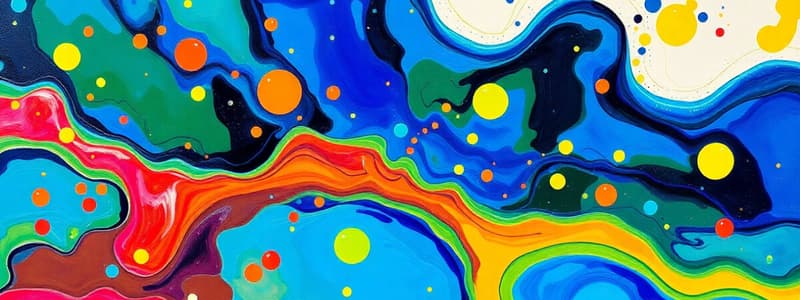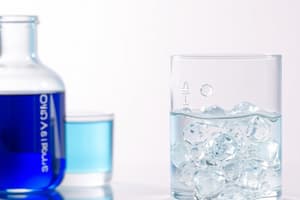Podcast
Questions and Answers
What is an aqueous solution?
What is an aqueous solution?
An aqueous solution is a solution in which the solvent is water.
Which of the following are examples of aqueous solutions?
Which of the following are examples of aqueous solutions?
Explain how water dissolves salts like sodium chloride.
Explain how water dissolves salts like sodium chloride.
Water dissolves salts by separating cations and anions, forming new interactions between water molecules and the ions. The positive sodium ions are attracted to the oxygen side of the water molecule, and the negative chloride ions are attracted to the hydrogen side, creating an ion-dipole interaction. This interaction overcomes the attraction between the sodium and chloride ions, leading to the dissolution of the salt in water.
Sugar dissolves in water because the attraction between sugar molecules and water molecules is weaker than the attraction between sugar molecules.
Sugar dissolves in water because the attraction between sugar molecules and water molecules is weaker than the attraction between sugar molecules.
Signup and view all the answers
What is an electrolyte?
What is an electrolyte?
Signup and view all the answers
Which of the following is NOT a strong electrolyte?
Which of the following is NOT a strong electrolyte?
Signup and view all the answers
What are the two main mechanisms by which water dissolves ionic substances?
What are the two main mechanisms by which water dissolves ionic substances?
Signup and view all the answers
All salts are non-electrolytes.
All salts are non-electrolytes.
Signup and view all the answers
A solution that contains no ions and does not conduct electricity is called a(n):
A solution that contains no ions and does not conduct electricity is called a(n):
Signup and view all the answers
What is the difference between a strong electrolyte and a weak electrolyte?
What is the difference between a strong electrolyte and a weak electrolyte?
Signup and view all the answers
The ability of a solution to conduct electricity depends only on the type of ions it contains, not the number of ions present.
The ability of a solution to conduct electricity depends only on the type of ions it contains, not the number of ions present.
Signup and view all the answers
What is a molecular equation?
What is a molecular equation?
Signup and view all the answers
What is a complete ionic equation?
What is a complete ionic equation?
Signup and view all the answers
What is the Arrhenius definition of an acid?
What is the Arrhenius definition of an acid?
Signup and view all the answers
The Arrhenius definition of acids and bases includes ions such as NH₄+ and HSO₄⁻.
The Arrhenius definition of acids and bases includes ions such as NH₄+ and HSO₄⁻.
Signup and view all the answers
The Arrhenius definition is applicable to both aqueous and non-aqueous solutions.
The Arrhenius definition is applicable to both aqueous and non-aqueous solutions.
Signup and view all the answers
What is the Brønsted-Lowry definition of an acid?
What is the Brønsted-Lowry definition of an acid?
Signup and view all the answers
Which of the following are typical Brønsted-Lowry bases?
Which of the following are typical Brønsted-Lowry bases?
Signup and view all the answers
What is an amphoteric substance?
What is an amphoteric substance?
Signup and view all the answers
What is autoionization?
What is autoionization?
Signup and view all the answers
Autoionization always occurs to a significant extent, resulting in a high concentration of H+ and OH- ions.
Autoionization always occurs to a significant extent, resulting in a high concentration of H+ and OH- ions.
Signup and view all the answers
What is the ion product of water or water dissociation constant, and how is it represented?
What is the ion product of water or water dissociation constant, and how is it represented?
Signup and view all the answers
The pH scale is a logarithmic scale where a change of 1 pH unit represents a ten-fold change in hydrogen ion concentration.
The pH scale is a logarithmic scale where a change of 1 pH unit represents a ten-fold change in hydrogen ion concentration.
Signup and view all the answers
What is the formula for calculating the pH of a solution?
What is the formula for calculating the pH of a solution?
Signup and view all the answers
The sum of pH and pOH for a solution is always 14.
The sum of pH and pOH for a solution is always 14.
Signup and view all the answers
Which of the following pH values indicates a basic solution?
Which of the following pH values indicates a basic solution?
Signup and view all the answers
PH meters are used to measure the concentration of hydroxide ions in a solution.
PH meters are used to measure the concentration of hydroxide ions in a solution.
Signup and view all the answers
What are strong acids?
What are strong acids?
Signup and view all the answers
Which of the following is NOT a strong acid?
Which of the following is NOT a strong acid?
Signup and view all the answers
What are weak acids?
What are weak acids?
Signup and view all the answers
The strength of a weak acid is inversely proportional to its Ka value.
The strength of a weak acid is inversely proportional to its Ka value.
Signup and view all the answers
What is the relationship between the pKa of an acid and its strength?
What is the relationship between the pKa of an acid and its strength?
Signup and view all the answers
What is the relationship between the pKb of a base and its strength?
What is the relationship between the pKb of a base and its strength?
Signup and view all the answers
Study Notes
Pharmaceutical Analytical Chemistry I, Lecture 7
- Aqueous solutions are solutions where the solvent is water.
- Examples of aqueous solutions include seawater, rain, juice, cola, and vinegar.
- Water dissolves salts by separating cations and anions.
- Water's polarity creates partial positive and negative charges on the oxygen and hydrogen atoms.
- Positively charged sodium ions are attracted to the oxygen side of water molecules.
- Negatively charged chloride ions are attracted to the hydrogen side of water molecules.
- This attraction (ion-dipole interaction) overcomes the attraction between the ions, causing the salt to dissolve.
- A hydration shell (sphere) forms around solute molecules, with water molecules interacting with the ions.
Aqueous Solutions and Solubility
- Solids like salt and sugar dissolve in water via separation of ions or intact molecules.
- The attraction between water and solute molecules overcomes the attraction between solute molecules.
- This process is important in many pharmaceutical applications.
Electrolyte and Nonelectrolyte Solutions
- Electrolytes are substances that conduct electricity in water because they ionize.
- They are categorized into strong and weak electrolytes.
- Strong electrolytes ionize completely and conduct electricity well, while weak electrolytes ionize only partially, thus conducting electricity poorly.
- Examples of strong electrolytes include acids like HCl, H₂SO₄, HNO₃, and bases like NaOH and KOH .
- Examples of weak electrolytes include acids like HCN, H₃BO₃, CH₃COOH, H₃PO₄, and H₂CO₃, and bases like Al(OH)₃.
- Nonelectrolytes, like sugars and glycerol, do not ionize and don't conduct electricity in water.
- All salts are strong electrolytes, such as NaCl, KCl, and CH₃COONa.
Comparison Between Electrolytes and Nonelectrolytes
- Electrical conductivity depends on the presence of charge carriers (ions).
- Strong electrolytes are completely ionized and conduct electricity well.
- Weak electrolytes are only partially ionized and conduct electricity poorly.
- Nonelectrolytes don't produce ions and don't conduct electricity.
Representing Aqueous Reaction Equations
- Molecular equations show neutral formulas of compounds in a reaction.
- Complete ionic equations show all species present in the solution, including ions from strong electrolytes.
Definitions of Acids and Bases
- Arrhenius definition: Acids produce H⁺ ions in aqueous solution, and bases produce OH⁻ ions.
- Example of an acid is HCl (hydrochloric acid) and NaOH (sodium hydroxide) for bases.
Limitations of Arrhenius Theory
- Includes only neutral substances and limited to aqueous media.
- Doesn't include ions, such as NH₄⁺ (ammonium ion), HSO₄⁻ (acid sulfate), and HCO₃⁻ (bicarbonate).
The Brønsted-Lowry Definition
- An acid is a proton (H⁺) donor, and a base is a proton acceptor.
- Water can function as both an acid and a base (amphoteric).
Conjugate Acid-Base Pairs
- A conjugate acid-base pair is related by the transfer of a proton.
- A conjugate acid results from adding a proton to a base.
- A conjugate base results from removing a proton from an acid.
Autoionization of Water and pH
- Water autoionizes to produce hydronium (H₃O⁺) and hydroxide (OH⁻) ions.
- pH is a measure of hydrogen ion concentration in a solution.
- pOH is a measure of hydroxide ion concentration.
- pH + pOH = 14 at 25°C.
- A neutral solution has pH = 7, acidic solutions have pH < 7, and basic solutions have pH > 7.
The pH Concept
- pH scale quantifies acidity and basicity based on hydrogen ion concentration.
- pH is calculated as -log[H⁺].
- pH values range from 0 to 14.
Strength of Acids and Bases
- Strong acids ionize completely in water.
- Examples include HCl, HNO₃, H₂SO₄, HBr, HI, and HClO₄.
- Weak acids ionize to a limited extent in water.
- Examples include CH₃COOH(acetic acid), HF (hydrofluoric acid).
- Strong bases ionize completely in water.
- Examples include NaOH, KOH, and Ca(OH)₂.
- Weak bases ionize only to a limited extent in water.
- Examples include NH₃ (ammonia).
Dissociation of Weak Acids and Bases
- Equilibrium expression for their ionization are used to determine the relative strength of acids and bases.
- Values of pKa and Kb are important to understand their strength.
Studying That Suits You
Use AI to generate personalized quizzes and flashcards to suit your learning preferences.
Related Documents
Description
Explore the fascinating world of aqueous solutions and solubility in this quiz based on Lecture 7 of Pharmaceutical Analytical Chemistry I. Learn how water interacts with different solutes and the role of ion-dipole interactions in dissolving substances. Test your knowledge on these fundamental concepts of chemistry!




